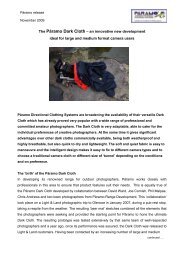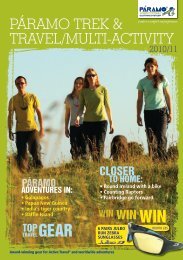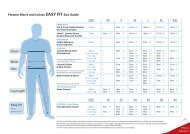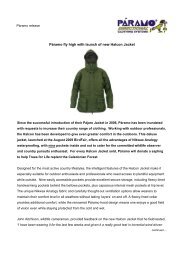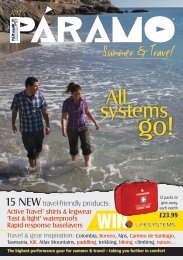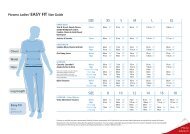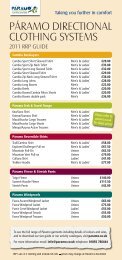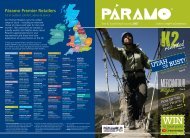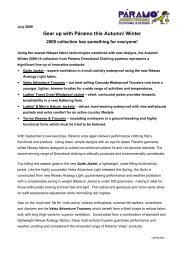Ethical shopping guide to outdoor gear - Paramo
Ethical shopping guide to outdoor gear - Paramo
Ethical shopping guide to outdoor gear - Paramo
You also want an ePaper? Increase the reach of your titles
YUMPU automatically turns print PDFs into web optimized ePapers that Google loves.
pho<strong>to</strong>graph by Michael Dempsey<br />
OUTDOOR GEAR SPECIAL<br />
Outdoor Gear Special<br />
fleeces, rucksacks, sleeping bags, tents,<br />
walking boots, and waterproof jackets<br />
Before you get kitted out for the great <strong>outdoor</strong>s this summer check out whether<br />
the companies you’re buying from care as much about the environment as you<br />
do. Bryony Moore, Tim Hunt and Simon Birch investigate.<br />
www.ethicalconsumer.org JULY/AUGUST ‘10
Why should hillwalkers care about the environmental<br />
impact of their walking jackets? And how do we get the<br />
<strong>outdoor</strong> industry <strong>to</strong> be more sustainable? asks <strong>outdoor</strong>nut<br />
and environmentalist Simon Birch.<br />
As a self-confessed <strong>outdoor</strong> obsessive, over the past 30 odd years I’ve<br />
been lucky enough <strong>to</strong> have climbed, mountain biked and trekked over<br />
large swathes of the wilder bits of the UK, Europe and beyond.<br />
Since I spend as much time as possible getting muddy and sweaty<br />
<strong>outdoor</strong>s, it’s always seemed perfectly logical <strong>to</strong> me <strong>to</strong> try and help<br />
protect the very thing that I feel so passionate about: namely the<br />
environment.<br />
So it’s been with a growing sense of surprise and disappointment<br />
that in the course of the compiling of this buyers’ <strong>guide</strong> I’ve discovered<br />
that very few of my fellow <strong>outdoor</strong> obsessives share my environmental<br />
concerns. A recent reader survey by Trail magazine – one of the UK’s<br />
leading <strong>outdoor</strong> magazines - revealed that the environment barely<br />
registers on the radar when people buy new <strong>outdoor</strong> <strong>gear</strong>.<br />
It’s a sad fact that few if any of the vast numbers of walkers who<br />
regularly head <strong>to</strong> the hills every weekend and who clearly love the<br />
<strong>outdoor</strong>s make the connection between their walking jackets, boots and<br />
other clobber and the whacking big environmental impact that results<br />
from their production.<br />
In trying <strong>to</strong> explain this lack of environmental awareness, some<br />
suggest that since the <strong>outdoor</strong> industry regularly uses the sweeping<br />
backdrop of dramatic mountains <strong>to</strong> help market and advertise their<br />
<strong>gear</strong>, the public assumes that the industry is by default environmentally<br />
responsible.<br />
Sadly as this buyers’ <strong>guide</strong> shows, this is far from the truth. Plus<br />
let’s not forget that it’s <strong>outdoor</strong> companies who are now increasingly<br />
acting like the fashion industry in being hell bent on flogging us ever<br />
increasing amounts of <strong>outdoor</strong> <strong>gear</strong>.<br />
Whilst some in the <strong>outdoor</strong> industry are at long last starting <strong>to</strong> talk<br />
about sustainability, few understand the basic contradiction between<br />
aiming <strong>to</strong> produce more sustainable <strong>gear</strong> and a profit-driven business<br />
model that relies on selling more and more.<br />
So what’s <strong>to</strong> be done? Some believe that it’s up <strong>to</strong> cus<strong>to</strong>mers <strong>to</strong><br />
wise-up and start piling the pressure on the <strong>outdoor</strong> industry <strong>to</strong><br />
clean up its act. Well I don’t buy this as I’m getting increasingly fed up<br />
with the current trend of dumping the responsibility for raising the<br />
environmental bar on<strong>to</strong> consumers.<br />
From where I’m standing it’s the <strong>outdoor</strong> industry that needs <strong>to</strong> start<br />
taking its environmental responsibilities more seriously. If a company<br />
is happy enough <strong>to</strong> use a mountain in its latest catalogue <strong>to</strong> help boost<br />
its profits, then it’s about time that the same company started <strong>to</strong> help<br />
protect it – and the rest of the environment <strong>to</strong>o.<br />
buyers’ <strong>guide</strong><br />
What’s in the Outdoor Special<br />
There’s a great irony that those who love the <strong>outdoor</strong>s can have such<br />
a negative environmental impact through the clothes and kit they<br />
buy <strong>to</strong> enjoy it. And with policies on workers’ rights in the <strong>outdoor</strong><br />
market lagging behind other clothing sec<strong>to</strong>rs it’s people, as well as the<br />
planet, that pay the price. While scandals about conditions in clothing<br />
supply chains have hit the big fashion labels and retailers, prompting<br />
change, the <strong>outdoor</strong> brands have failed <strong>to</strong> keep up. Few companies have<br />
environmental policies, with only two across all the products reviewed<br />
getting anything but a ‘Worst’ rating for our ‘Environmental Reporting’<br />
category. And even fewer have policies on <strong>to</strong>xic chemicals or the<br />
controversial issue of nanotechnology.<br />
We’ve covered six products:<br />
fleeces page 8<br />
waterproof jackets page 10<br />
walking boots page 12<br />
sleeping bags page 14<br />
tents page 16<br />
rucksacks page 18<br />
Each has its own score table and best buy advice. In <strong>to</strong>tal we’ve<br />
researched over 60 companies <strong>to</strong> give you the broadest possible range of<br />
brands <strong>to</strong> choose from. It’s a very congested market and we enlisted the<br />
help of experts from market research company OutdoorI <strong>to</strong> advise us<br />
on which brands <strong>to</strong> review <strong>to</strong> give a good cross section of the market.<br />
As well as asking companies about their environmental and supply<br />
chain policies we asked companies questions about the following areas<br />
key <strong>to</strong> this market:<br />
Cot<strong>to</strong>n<br />
We asked companies if they have a policy that covers<br />
• the use of genetically modified cot<strong>to</strong>n,<br />
• pesticides and herbicides,<br />
• and sourcing from Uzbekistan, a country with an appalling human<br />
rights record and massive use of forced child labour in its cot<strong>to</strong>n<br />
industry.<br />
Toxics<br />
We asked companies if they have a policy that<br />
• quantifies the chemicals used in manufacture and sets targets for<br />
the phasing out of the most dangerous,<br />
• covers the use of nano technology, which is often used in the<br />
manufacture of waterproof and breathable fabrics.<br />
Animal rights<br />
We asked<br />
• Do companies use goose down in sleeping bags, leather in boots<br />
or merino wool from Australia.<br />
Unsustainable resources<br />
We asked whether companies manufacture synthetic products derived<br />
from oil. Those companies that have a majority of products derived<br />
from oil receive a half mark in the Habitats & Resources column.<br />
In the pages that follow we unpack the issue of nano-technology in<br />
fabrics (page 20), pit synthetic materials against natural ones (page<br />
21), and look at an exemplar of good practice from Canada (page<br />
14). We also investigate how the sec<strong>to</strong>r impacts animal rights (pages<br />
11 & 15) and supply chain issues (page 17).<br />
JULY/AUGUST ‘10 www.ethiscore.org
OUTDOOR GEAR SPECIAL<br />
Waterproof Jackets<br />
Ethiscore (out of 20)<br />
Environmental Reporting<br />
Nuclear Power<br />
Company profiles - fleeces<br />
and waterproof jackets<br />
Arc Teyx’s website explicitly states that<br />
it does not use recycled materials. They<br />
suggest recycled fabrics take more energy<br />
<strong>to</strong> produce than virgin materials and also<br />
do not perform as well. 15 However, none<br />
10 www.ethicalconsumer.org JULY/AUGUST ‘10<br />
Environment Animals People Politics +ve<br />
Climate Change<br />
Pollution & Toxics<br />
Habitats & Resources<br />
Animal Testing<br />
BRAND COMPANY GROUP<br />
Páramo 13.5 h Páramo Ltd<br />
Lowe Alpine 10.5 H h h H h Lowe Alpine International<br />
Patagonia [R] 10.5 H h h H h h h 1 Lost Arrow Corporation<br />
Rohan 10.5 H h h H h Rohan Group<br />
Snugpak 10.5 H h h H h Snugpak Ltd<br />
Jack Wolfskin [R] 10 H H h H h h h 1 Jack Wolfskin<br />
Montane [R] 10 H h h h h H h 0.5 Chonos<br />
Columbia [R] 9.5 H H h H h h h 0.5 Columbia Sportswear Co<br />
Haglofs [R] 9.5 H H h H h h Ra<strong>to</strong>s AB<br />
Mountain Hardwear [R] 9.5 H H h H h h h 0.5 Columbia Sportswear Co<br />
Sprayway [R] 9.5 H H h H h H h 1 Bollin Group<br />
Trespass 9.5 H H h h H h Jacobs and Turner<br />
Vaude 9.5 H h H h H h Vaude Sport GmbH<br />
Highlander 9 H H h h H h h Highlander (Scotland0 Ltd<br />
Rab 9 H h h H h H h Equip Outdoor Technologies<br />
Peter S<strong>to</strong>rm 8.5 H H h H h H h Blacks Leisure Group<br />
Regatta 8.5 H H h H h h h h Risol Imports<br />
Craghoppers 8 H H h H h h H h Risol Imports<br />
Mammut 8 H H H h H h h h Tegular AG<br />
Timberland [R] 8 H H h H H H h h h 1 Timberland<br />
Howies 7.5 h H h H H H h h h Timberland<br />
Marmot 7.5 H H H H h H h h Jarden Corporation<br />
Merrell 7.5 H h h H H H h h h Wolverine Worldwide Inc<br />
North Face 7.5 H H h H H H h h VF Corporation<br />
Arc’Teryx 6.5 H H h H H h H h H Amer Sports Corporation<br />
Berghaus 6.5 H H h H H H H h h Robert Stephen Holdings<br />
Salomon 6.5 H H h H H h H h H Amer Sports Corporation<br />
Quechua 4.5 H H H H H H H H H h Mulliez Family<br />
Helly Hansen 4 H H H h H H H H h H h h Al<strong>to</strong>r Equity Partners<br />
USING THE TABLES [R] = made from recycled materials<br />
Fac<strong>to</strong>ry Farming<br />
Animal Rights<br />
Human Rights<br />
Workers’ Rights<br />
Supply Chain Policy<br />
Irresponsible Marketing<br />
of the other companies that used recycled<br />
textiles mentioned these issues.<br />
Arms & Military Supply<br />
Genetic Engineering<br />
Berghaus is ultimately owned by Robert<br />
Stephen Holdings, which also owns a<br />
number of other household brands<br />
including Brasher, Ellese, JD Sports,<br />
Speedo and Kickers. They are one of only<br />
Boycott Call<br />
Political Activity<br />
Anti-Social Finance<br />
Company Ethos<br />
Product Sustainability<br />
Ethiscore: the higher the score, the better the company across the criticism categories. H bot<strong>to</strong>m rating h middle rating <strong>to</strong>p rating (no criticisms)<br />
See ‘Our Rating System’ page at www.ethicalconsumer.org for category definitions<br />
Positive ratings (+ve): Company Ethos: � full mark � half mark Product Sustainability: Maximum of five positive marks<br />
Buyers’ Guides Plus - see all the research behind these ratings <strong>to</strong>gether with a PDF of this report at www.ethicalconsumer.org. £3 or free <strong>to</strong> subscribers.<br />
4 companies in this report with a <strong>to</strong>p mark<br />
for supply chain policy. However they<br />
also have operations in China, Vietnam,<br />
Indonesia, Thailand and the USA that are<br />
currently on <strong>Ethical</strong> Consumer’s oppressive<br />
regimes list, which earns them a black mark<br />
under Human Rights.
BES T BUY<br />
ethical consumer magazine<br />
Best Buy: Páramo (01892 78644)<br />
Although not eligible for the Best Buy<br />
label, Patagonia (08000260055), Jack<br />
Wolfskin (01671 401115) and Montane<br />
(01670 522 300) all produce waterproof<br />
jackets that are made from recycled<br />
material. They are recommended as the<br />
next best option.<br />
10.5<br />
Company Profiles continued...<br />
10<br />
13.5<br />
Columbia Sportswear gets animal rights<br />
marks for the sale of hunting and fishing<br />
equipment and selling leather. They also<br />
own the Mountain Hardwear brand.<br />
Owners of Helly Hansen, Al<strong>to</strong>r Equity<br />
Partners, also own Meyn Food Processing,<br />
which is a massive manufacturer of<br />
equipment for processing intensivelyfarmed<br />
chickens. It also owns Ferrosan,<br />
which produces pharmaceuticals and<br />
health supplements, but has no policy on<br />
animal testing, therefore scoring <strong>Ethical</strong><br />
Consumer’s worst rating in this category.<br />
buyers’ <strong>guide</strong><br />
Don’t let Australian sheep farmers pull the<br />
wool over your eyes<br />
Poorva Joshipura, Direc<strong>to</strong>r of Special Projects, People for the <strong>Ethical</strong> Treatment of<br />
Animals (PETA) looks at the hard truth behind soft wool.<br />
Commonly used for wool, Merino sheep are bred <strong>to</strong> have excessively wrinkly skin, so<br />
they’ll produce higher yields. Because of this, their skin collects moisture and attracts flies,<br />
who lay eggs in the folds of the sheep’s skin. The hatched maggots often eat away at the<br />
sheep’s skin, a problem known as “flystrike.” Most Merino wool sold throughout the world<br />
comes from Australia. In an attempt <strong>to</strong> create smooth, scarred skin that won’t harbor fly<br />
eggs, many Australian sheep farmers cut flesh from lambs’ hindquarters with gardening<br />
shears—without using painkillers. A practice know as ‘mulesing’.<br />
There are humane and effective alternatives. No other country muleses sheep—New<br />
Zealand s<strong>to</strong>pped mulesing 10 years ago. Many Australian woolgrowers have s<strong>to</strong>pped<br />
mulesing their lambs, opting <strong>to</strong> use better husbandry methods or breed bare-breeched<br />
sheep, who don’t have wrinkly skin on their bot<strong>to</strong>ms and therefore aren’t susceptible <strong>to</strong><br />
flystrike.<br />
In 2004, the trade group Australian Wool Innovation (AWI) pledged <strong>to</strong> end mulesing in<br />
Australia by 2010, but in July of 2009, after years of stalling, it announced that it wouldn’t<br />
meet the deadline as promised. Compassionate consumers and progressive retailers feel<br />
the AWI is taking way <strong>to</strong>o long <strong>to</strong> s<strong>to</strong>p mulesing. While it was making excuses, a number<br />
of retailers, including Liz Claiborne, Next, Gap Inc., HUGO BOSS, Perry Ellis, Adidas,<br />
and H&M, signed a pledge put forward by PETA US <strong>to</strong> move away from mulesed wool or<br />
implemented an outright ban on wool from mulesed lambs.<br />
PETA US, which launched a campaign <strong>to</strong> end mulesing in 2005, recently asked Tony<br />
Burke, Australian Minister of Agriculture, <strong>to</strong> promote a genetic solution, such as barebreech<br />
breeding, and <strong>to</strong> set a two-year government deadline <strong>to</strong> end mulesing. Wool industry<br />
insiders agree that this deadline is reasonable. If Mr. Burke accepts this deadline, PETA US<br />
will extend its retail campaign mora<strong>to</strong>rium while Australia sheep farmers implement a<br />
genetic solution.<br />
Bare-breech breeding, or a similar genetic solution, is an effective long–term alternative <strong>to</strong><br />
mulesing. However; consumers can best help sheep and other animals by choosing clothing<br />
made from non-animal materials.<br />
For more information see www.SavetheSheep.com.<br />
JULY/AUGUST ‘10 www.ethiscore.org 11



